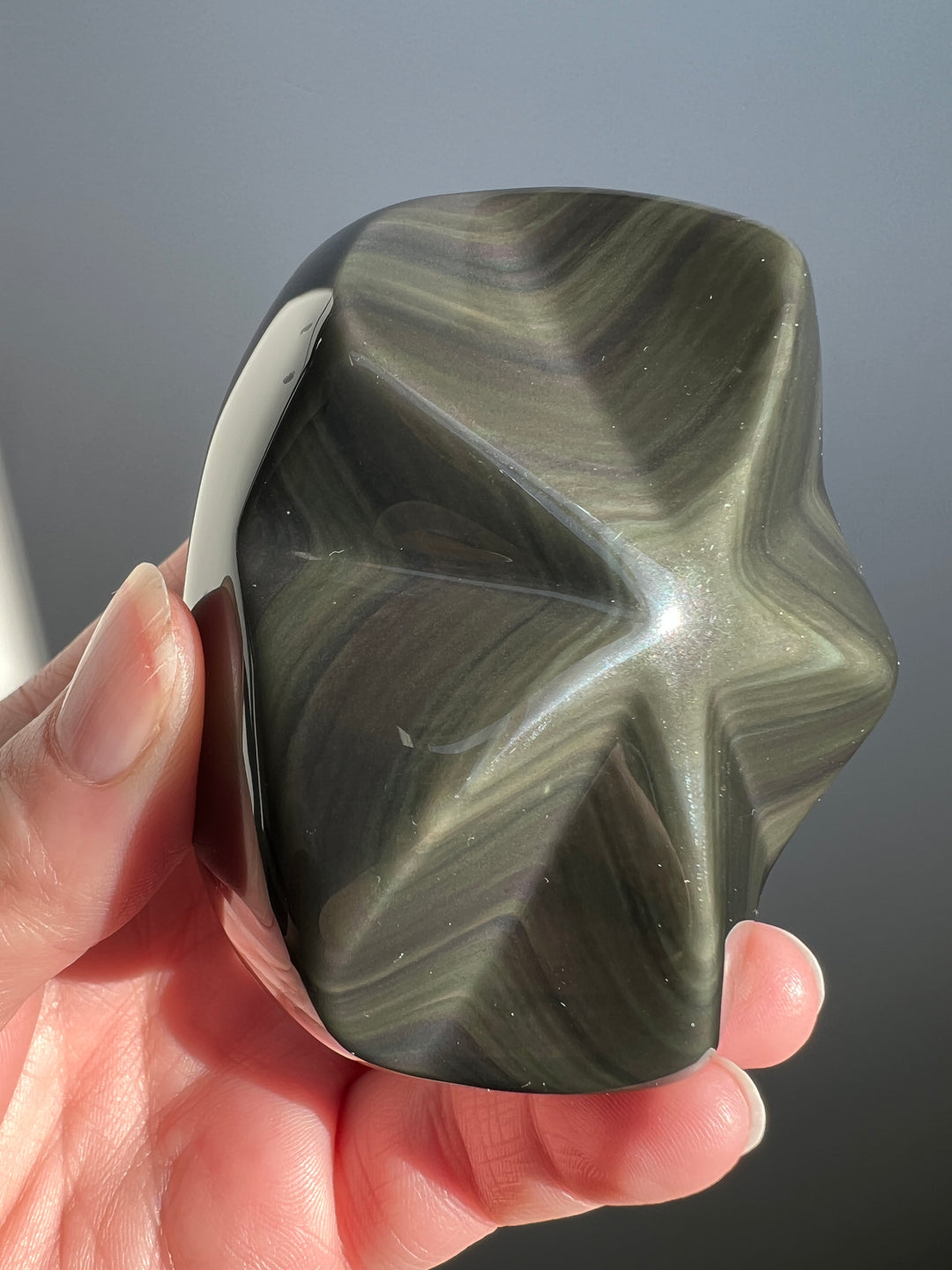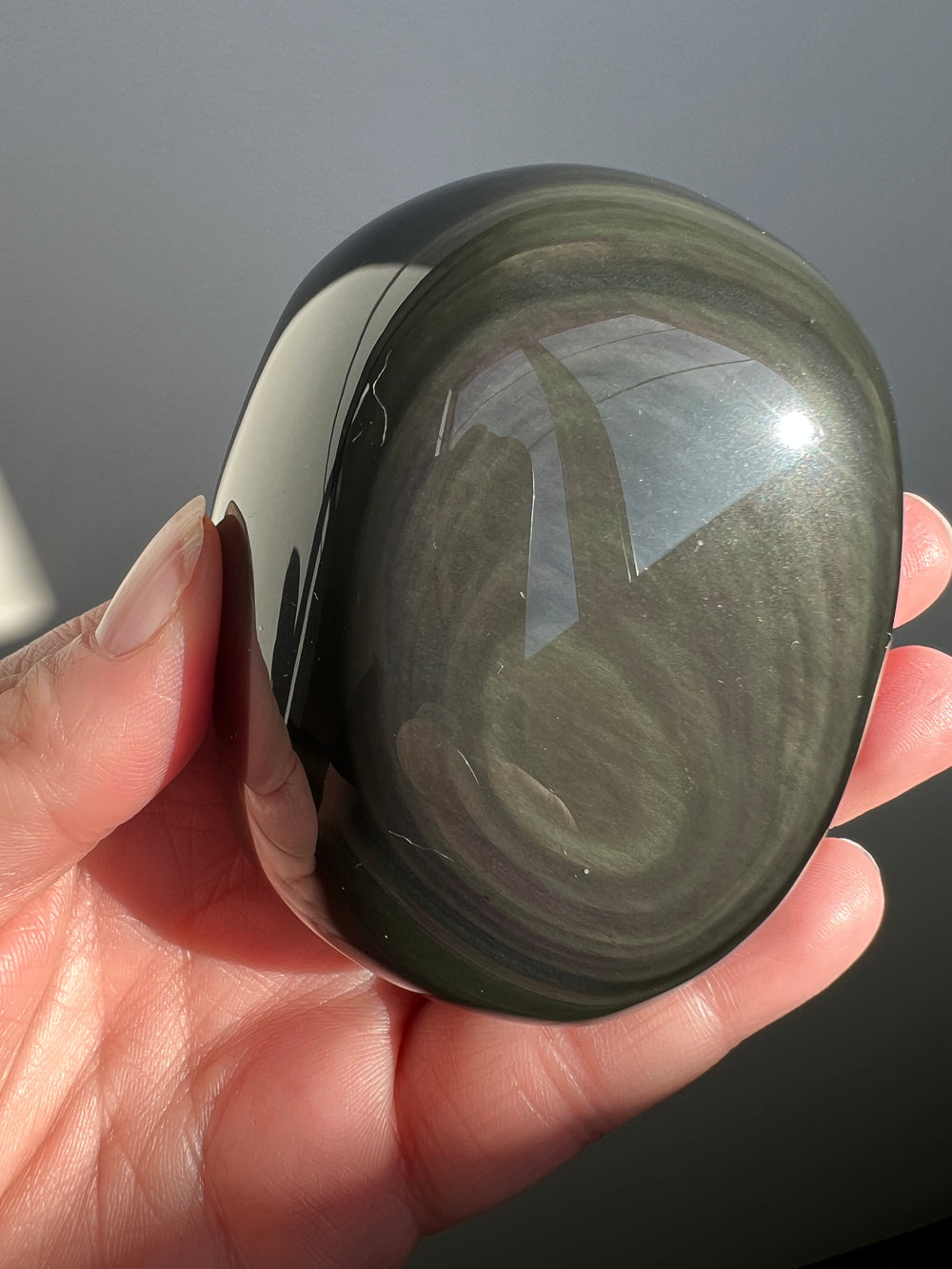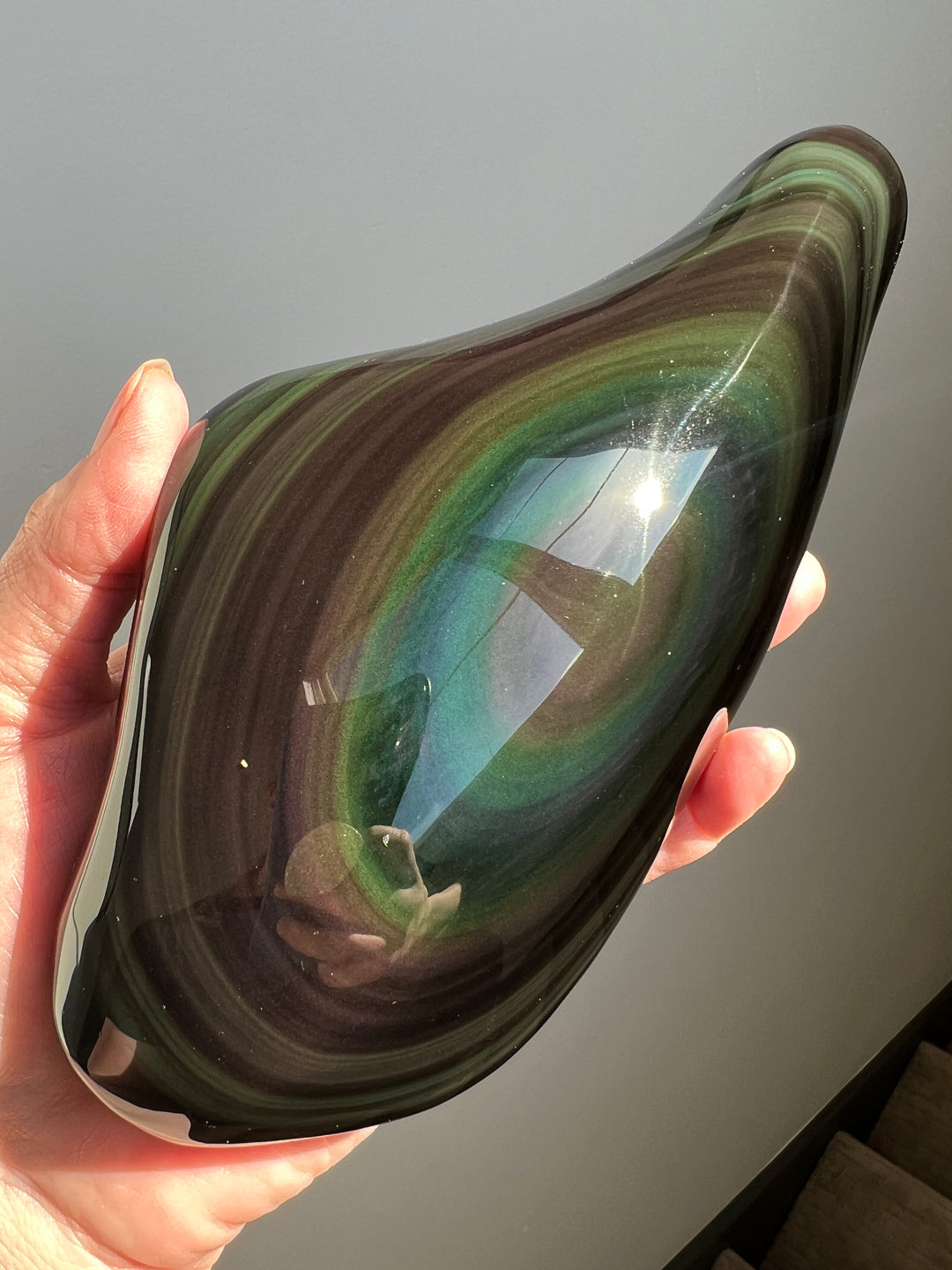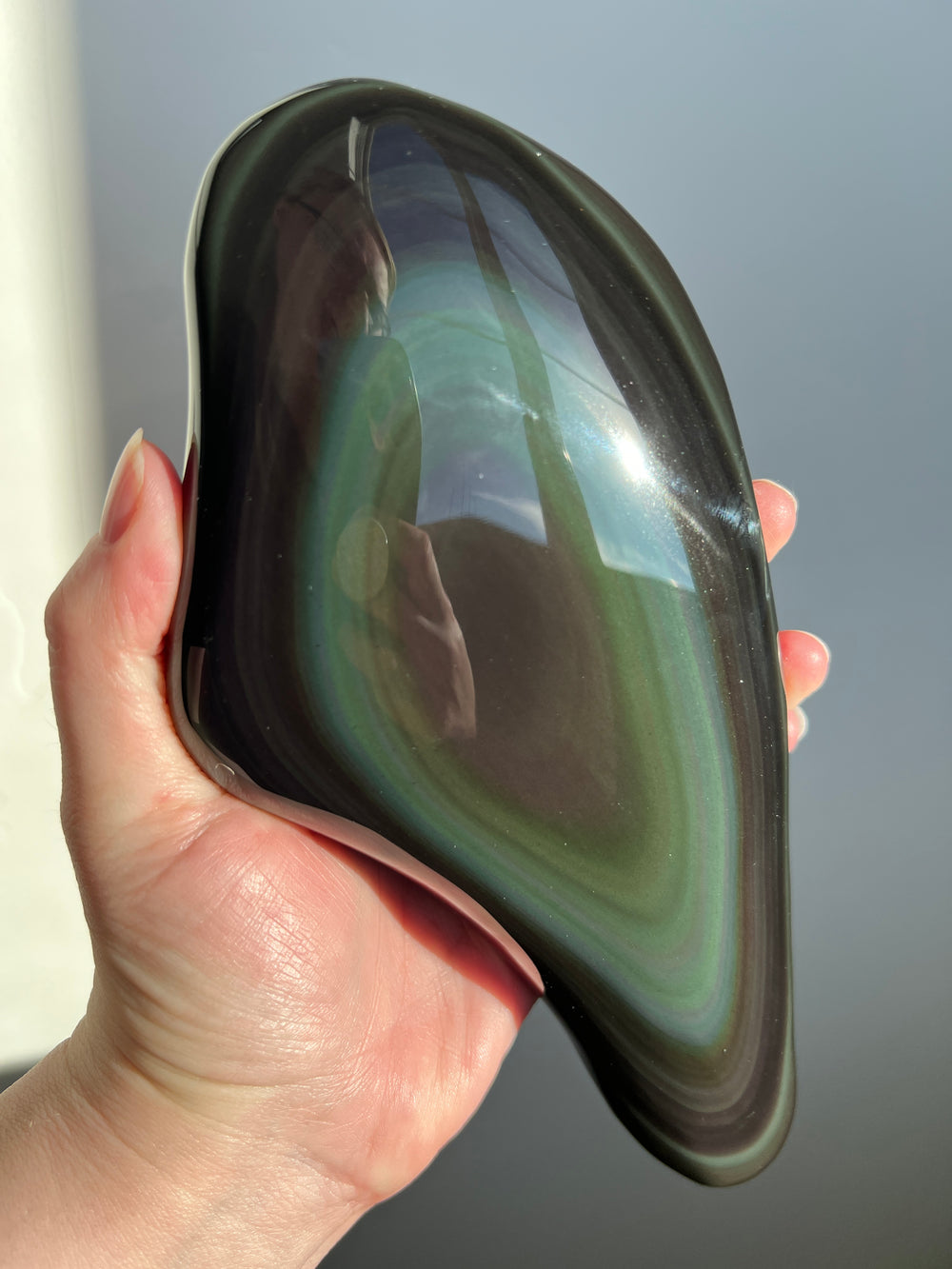Rainbow Obsidian | FAQ
Q: What is Rainbow Obsidian? A: Rainbow Obsidian is a type of natural volcanic glass formed when lava cools rapidly. It's characterized by its dark color, usually black or deep brown, and iridescent layers that can show various colors when light reflects off of them. These colors often appear in circular or band-like patterns, creating a rainbow-like effect.
Q: What healing properties are attributed to Rainbow Obsidian? A: Rainbow Obsidian is believed to have powerful healing and protective properties. It's thought to aid in emotional healing, providing a shield against negativity and helping to release stress and tension. It's also said to bring hope, illumination, and energy, helping to clear and balance the emotional body.
Q: How can Rainbow Obsidian be incorporated into meditation or spiritual practices? A: In meditation and spiritual practices, Rainbow Obsidian is often used for grounding and centering. It's believed to help in the healing of emotional wounds, to provide insight into difficult situations, and to encourage personal growth and the exploration of the unknown.
Q: What unique characteristics does Rainbow Obsidian possess? A: Rainbow Obsidian's most distinctive feature is its iridescent layers that can display a spectrum of colors, often appearing as bands or circular patterns across the stone. This iridescence gives the otherwise dark stone a unique and captivating appearance.
Q: What is the Mohs hardness of Rainbow Obsidian? A: Rainbow Obsidian, like other forms of obsidian, ranks about 5 to 6 on the Mohs scale of hardness. While it can be relatively easy to work with, it's also somewhat fragile and can break or chip upon impact.
Q: Is Rainbow Obsidian suitable for use in jewelry making? A: Yes, Rainbow Obsidian is used in jewelry, particularly as cabochons or polished stones. Due to its glassy nature and relative softness, it's best set in pieces that aren't subjected to heavy wear, such as pendants or earrings.
Q: How should Rainbow Obsidian be cared for and cleaned? A: Rainbow Obsidian should be cleaned using mild soap and lukewarm water, and dried with a soft cloth. Avoid harsh chemicals and abrasives, as they can scratch the surface. Also, protect it from hard blows to prevent chipping or breaking.
Q: What significance do the color and patterns of Rainbow Obsidian hold? A: The colorful iridescence of Rainbow Obsidian is often associated with hope, happiness, and spiritual transformation. It's believed to symbolize the journey from darkness to light and is thought to bring clarity, peace, and balance to the wearer.
Q: What metaphysical properties are associated with Rainbow Obsidian? A: Metaphysically, Rainbow Obsidian is said to be a powerful stone for grounding and protection. It's believed to help in emotional healing, to cleanse and align the aura, and to assist in releasing stress and negative energy.
Q: What are the geological properties of Rainbow Obsidian? A: Geologically, Rainbow Obsidian is formed from volcanic activity. It's a type of rhyolitic lava that cools quickly, with inclusions and microscopic mineral crystals creating the iridescent effect.
Q: Can you explain the scientific properties of Rainbow Obsidian? A: Scientifically, Rainbow Obsidian is a natural glass formed from rapidly cooling lava. It consists mainly of silicon dioxide (SiO2) and a variety of impurities that contribute to its coloration.
Q: What is the mineral composition of Rainbow Obsidian? A: Rainbow Obsidian is primarily composed of silicon dioxide, with traces of water and other minerals. The specific composition can vary, which influences the color and pattern of the iridescence.
Q: Does Rainbow Obsidian fade or change color over time? A: Rainbow Obsidian is generally stable and does not fade easily. However, it's advisable to protect it from harsh chemicals and extreme temperature changes, which could potentially alter its appearance.
Q: How can I distinguish between real and fake Rainbow Obsidian? A: Genuine Rainbow Obsidian should have a smooth, glassy surface with natural color variations. Fakes might be made from dyed glass or plastic and often lack the depth and natural flow of color found in real Rainbow Obsidian.
Q: How is Rainbow Obsidian formed? A: Rainbow Obsidian forms when felsic lava from a volcanic eruption cools rapidly with minimal crystal growth. The presence of inclusions and microscopic mineral crystals within the lava creates the rainbow-like iridescence.
Q: Are there different types or variations of Rainbow Obsidian? A: While the basic composition of Rainbow Obsidian is consistent, variations can occur in the pattern and intensity of the iridescent colors. Some pieces may exhibit more pronounced rainbow patterns or different color spectrums.
Q: What's the historical significance of Rainbow Obsidian? A: Obsidian, including Rainbow Obsidian, has been used since prehistoric times for making tools, weapons, and ornaments. Its glassy nature made it ideal for creating sharp blades. In various cultures, it has also been valued for its supposed mystical and healing properties.
Q: What is the origin of Rainbow Obsidian? A: The term "Rainbow Obsidian" refers to its iridescent quality, reminiscent of a rainbow. It is found in regions with volcanic activity, including Mexico, the United States, and Iceland.
Q: Where is Rainbow Obsidian typically found? A: Significant sources of Rainbow Obsidian include volcanic regions like Mexico, particularly in the states of Jalisco and Nayarit, as well as parts of the western United States and Iceland.
Q: How rare is Rainbow Obsidian? A: Rainbow Obsidian is relatively common in areas with volcanic activity. However, high-quality specimens with vivid and well-defined rainbow patterns are more rare and sought after by collectors and gem enthusiasts.









